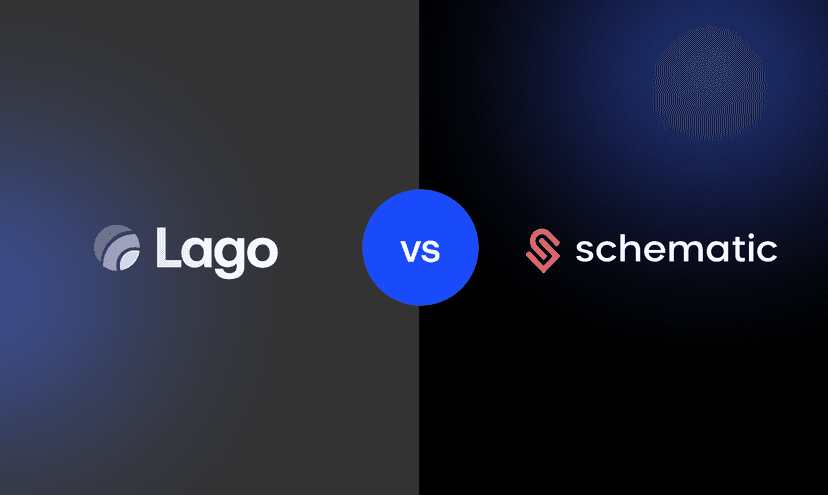

Modern SaaS and AI companies can’t afford to treat billing as an afterthought. The right platform doesn’t just generate invoices — it determines how quickly you can launch new products, experiment with pricing, and capture revenue.
Schematic and Lago have both quickly become popular choices for teams moving beyond legacy billing tools. Both start from the same belief: traditional platforms are too rigid and slow for the pace of modern product development. A new generation of billing infrastructure should be easier to manage, more flexible to integrate, and empowering for the business.
Where they differ is in emphasis:
Schematic focuses on speed and empowerment — helping GTM teams iterate quickly with drop-in components and entitlements built into the product experience.
Lago requires significant engineering investment — open-source, self-hostable, and payment system agnostic, requiring engineering and finance teams to build and maintain most of the billing infrastructure themselves.
What follows is a deeper dive into how Schematic and Lago approach modern billing, what their differences mean in practice, and help you decide which approach best fits your needs.
Both Lago and Schematic want to fix what legacy billing platforms got wrong: complexity, rigidity, and a lack of flexibility for modern SaaS and AI companies. Where they diverge is in emphasis. Lago optimizes for openness and control at the cost of greater engineering investment and ongoing maintenance, while Schematic integrates deeply with Stripe to optimizes for speed and go-to-market empowerment.
Lago (Openness & Flexibility) | Schematic (Speed & Empowerment) | |
Entitlements & Enforcement | Entitlements model available, but you must build enforcement yourself via alerts/webhooks. | Entitlements and feature flags evaluated in-app, enabling real gating and overage enforcement. |
Payments | Native support for Stripe, Adyen, GoCardless, plus custom providers. | Deep bi-directional integration with Stripe. |
Pricing Models | Support for all modern models (usage based, credit burndown, etc.) | Support for all modern models (usage based, credit burndown, etc.) |
Customer Experience | You must build your own UI, or pay extra for premium portal. | Drop-in Portal and Checkout components for upgrades, invoices, and add-ons. |
Developer Experience | Open source flexibility, modular services, self-host option; significant assembly and maintenance required. | Opinionated SDKs + managed SaaS; optimized for speed and iteration. |
Best Fit | Teams needing infra control, multiple Payment systems, or ERP/tax depth. | Teams wanting to ship monetization changes quickly with integrated product UX. |
Lago includes an entitlements model, letting you define feature access, allowances, or quotas. However, when customers approach limits, Lago only sends alerts or webhooks, leaving the critical enforcement logic entirely up to your application to build and maintain.
Schematic bakes entitlements into the product layer. Plans are defined by entitlements, and feature flags in your code check them at runtime. That means you don’t just know when a customer crosses a limit, you can automatically gate the feature and trigger a paywall or upgrade flow. It closes the loop between pricing and product.
Lago requires more configuration on the payments side. While it supports Stripe, Adyen, and GoCardless out of the box, you'll need to do additional work to add custom payment providers. It also integrates with finance systems like NetSuite and tax engines such as Anrok or Avalara, but this adds complexity for companies that don't have heavy ERP or compliance needs.
Schematic, by contrast, is built to integrate deeply with Stripe. Its drop-in components and billing layer are built around Stripe’s payments flow. This provides less flexibility, but a smoother experience if your company is already standardized on Stripe.
Lago is designed for teams that want maximum control, but this comes at a cost. Being open-source and self-hostable means your engineering team must manage every piece of the stack. Its modular design (events, metrics, billing, wallets) requires you to assemble components yourself and handle ongoing maintenance—adding significant engineering overhead to your team's responsibilities.
Schematic is more opinionated. It provides SDKs, feature flags, and managed infrastructure that connect entitlements, usage, and billing in one model. Instead of piecing together primitives, developers wire into Schematic’s system and get billing, enforcement, and customer-facing UX in one package. Schematic is built for companies that don't want to staff a billing engineering team.
Lago provides basic primitives to handle invoicing and payments, but most customer-facing experiences (e.g. upgrades, add-ons, paywalls) must be built from scratch by your team. They do offer a premium Customer Portal for an additional cost, but the default expectation is that you'll need to build most of the UI yourself.
Schematic takes a different approach with drop-in Customer Portal and Checkout components. Customers can upgrade plans, purchase add-ons, or review invoices without you writing that UI from scratch. For teams that want to move fast and don't want billing UX on their design backlog, this can be a major accelerant.
Lago and Schematic both reflect the new wave of billing platforms: easier to manage, more flexible to integrate, and better aligned with how SaaS and AI companies operate today.
The difference is emphasis:
Lago = extensive engineering investment: It's open source, self-hostable, Payment system agnostic, and deeply finance-friendly, but requires significant development resources and ongoing maintenance. Best for teams that have dedicated billing engineering resources and are willing to build most of the product experience themselves.
Schematic = speed and empowerment: It’s managed, Stripe-first, and product-integrated, with entitlements and drop-in components that let business teams iterate pricing without code changes. Best for teams that want billing to feel like part of the product and to move quickly.
In short: if your priority is control and you have extensive engineering resources, Lago is an option. If your priority is velocity and getting to market quickly, Schematic is the better fit.